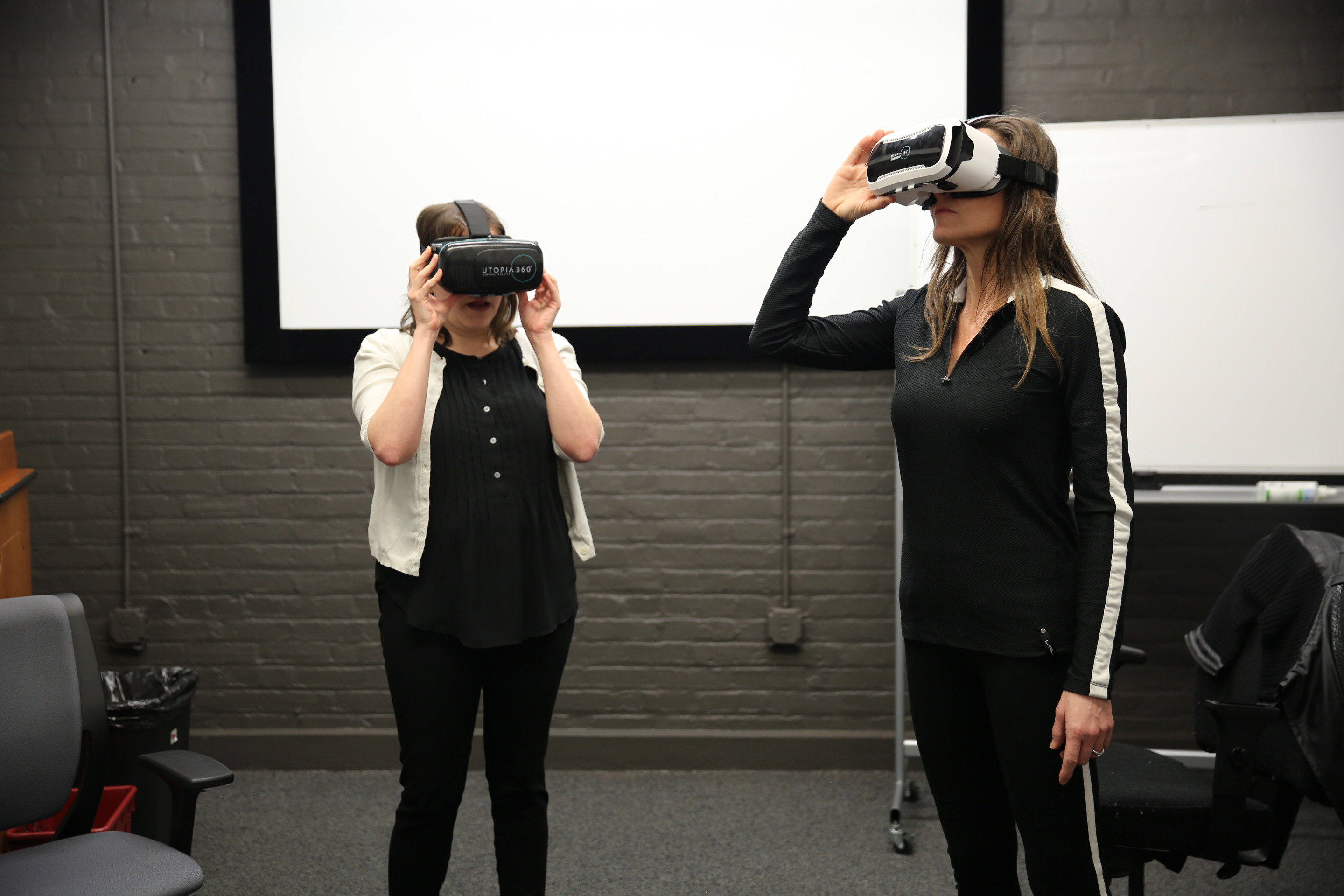Media and Communication Studies Major Settled After Relocation From Marist Hall

Professors Maura Ugarte and Lavinia Pasquina test out virtual reality equipment in class. Courtesy of Abby Moser

By Jimmy Cassidy, Daniela Sol
The Media & Communication Studies department has found its new home in the Crough Center of Architectural Studies this fall, after its complete relocation from Marist Hall.
Media students and faculty have expressed optimism for the department since the relocation, and are excited about the future of the program, in particular the new video production equipment, current work being done outside of the classroom by faculty, and the new collaborative virtual reality course.
In the late fall of 2016, severe structural concerns to Marist Hall caused a majority of regularly scheduled classes to be relocated on campus so that constructions repairs could begin. Not long after, faculty members began to lose their offices depending on their location in the building. When conditions weren’t quickly remedied, the department had to fully relocate. Thus, the following summer became an extremely busy one as the major’s production lab, equipment, and offices all made the transition to the basement of the Crough building.
“It meant a very busy summer of 2017, but by and large we’ve settled in here, and we’re happy mostly about getting our lab in here to have our whole program in one place,” said Dr. Stephen McKenna, chair of the Media and Communication Studies department. “It’s one thing we wanted to achieve with Marist.”
The space in Crough has a handful of offices for the faculty, an updated media lab for production students to edit videos, and an additional classroom that has been made into a lighting studio. Although it was a challenge moving the department, media lab director Abby Moser is confident the change of scenery will be a positive impact for the major.
“Our new, more central location in Crough has made us feel more integrated into the life of the campus and we really appreciate the warm welcome we have received from the School of Architecture,” Moser said. “The layout of our new lab has made it more of a hub for people to gather and has increased the sense of community among our production students.”
Upperclassmen media students have taken courses in Marist, O’Boyle Hall, and now Crough, and feel that the relocation is a good move given the circumstances.
“Despite the fact that some faculty members have left and we had to move out of our old department building, I’m hopeful for the future of the department,” said senior Virginia Reynolds. “Being in Crough has actually been so nice – it’s more central to campus, so I feel more inclined to meet with my professors!”
Other students like Mohammed Almujel have found pride in the expertise of their faculty in their respective fields.
“I feel like we’re a family here. All the professors are highly intelligent, and nice,” Almujel said. “I consider most of them geniuses in their field.”
One such expert is professor Maura Ugarte, a producer and editor who teaches the production courses for the department. She recently received a CINE Golden Eagle award for her work in a documentary about an injured Iraq War veteran.
Professor Josh Shepperd teaches a number of media theory-related courses in the department, but also acts as the first Sound History Fellow at the Library of Congress, where he works on radio preservation for the country’s history. It’s an effort that consists of 250 participating professors and over 200 universities in the United States. For him, media studies is a major that complements all others, an asset in any professional endeavor.
“One thing that is important to know about Media Studies is that media is naturally an interjector and multidisciplinary,” Shepperd said. “Students can often take our classes and find their studies in media to be directly applicable, without conflicting, to their work in other departments.”
One such interdisciplinary effort is a new virtual reality class offered for the first time this semester. Co-taught by Ugarte and architecture professor Lavinia B. Fici Pasquina, the course has six media and six architecture students learning about the new technology of 360 degree filmmaking. The department also received financial support from the School of Arts & Sciences to purchase new industry standard cameras, LED lighting sets, and tripods for the production lab this year.

McKenna notes that there is opportunity for growth in the department, but current financial stress on the university presents challenges. Increased collaborative efforts between majors could benefit many students at Catholic, like one idea of drama students enjoying an “Acting for the Camera” course while media students practice their production skills. These ideas, though, need qualified instructors, which might not be in the budget.
“The concern is being able to hire faculty to teach all of these cool ideas,” McKenna said. “That is the most expensive thing in growing a program.”
Also on the to-do list for the department: hiring a film studies professor. Dr. Martin Johnson filled this position for the major before leaving to teach film at the University of North Carolina at the end of this past fall semester. The search will begin soon to fill out the department’s faculty that comprises a variety of disciplines.
The transition has not been an easy one, but the relocation has provided the Media and Communication Studies major with stability and one central location on campus.
“It hasn’t been perfect, we’ve had to make sacrifices, but the new space is highly functional and it works well,” McKenna said. “It took all of our energy this summer to just get settled so we could be open for business on day one in the fall.”







